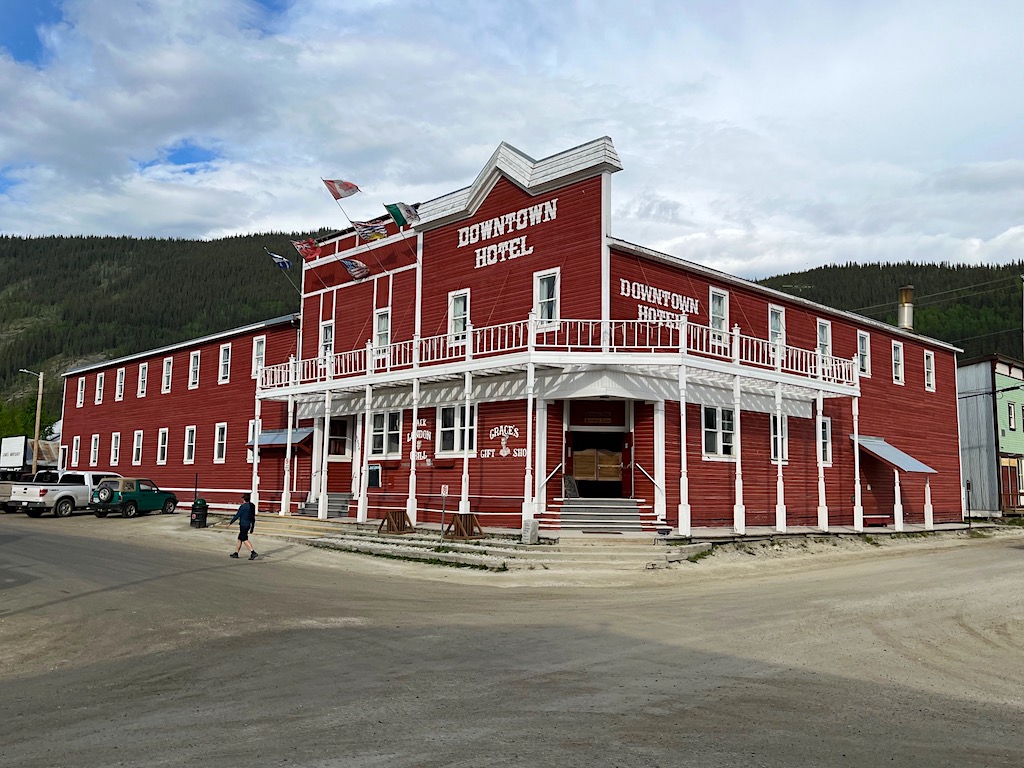





This day we had a 5:00am wakeup call as we had to have our bags out for a 7:00am departure to our next stop, Dawson City. We boarded a plane for the short 40-minute flight to Dawson City, Yukon Territory, once the heart of the Klondike Gold Rush. The time changed from Alaskan time zone to the same time zone as the west coast so we lost an hour of the day. Dawson City has a population of about 1,300 inhabitants. The Han Speaking people of the Tr’ondek Hwech’in and their forebears hunted here prior to the Late Modern Period. The current settlement was founded by Joseph Ladue in 1897, and was named after noted Canadian geologist, George M. Dawson, who had explored and mapped the area from 1887.
Dawson City was the center of the Klondike Gold Rush that began in 1896 and changed the First Nations camp into a thriving city of 40,000 people by 1898. The gold rush had ended by 1899 and the town’s population plummeted to about 8,000 inhabitants. When Dawson was incorporated in 1902 the population was less than 5,000. After World War II the Alaskan Highway was built some 300 miles south, bypassing the town and dropping its population further. By the 1960’s and 1970’s the population languished around 600 to 900.
Jack London, the American novelist, who write The Call of the Wild, lived in the Dawson area from October 1897 to June of 1898. Due to the increase in the value of gold, modern day Dawson still has some gold mining activity and a thriving tourism and arts scene.
Dawson City has only one paved street, Front Street that runs along the Yukon River. All of the other streets are dirt with no sidewalks, curbs or gutters. On the busier, more well-traveled streets they have boardwalks for sidewalks. Many of the buildings in town date back more than 100 years when the town was founded. Much of the town needs repair, updating and a coat of paint while other buildings are beautifully restored and freshly painted.
Our hotel was the Westmark-Dawson City owned by the Carnival Corporation. The hotel is spread across several blocks with different vintage buildings, some dated and some much more recent construction although built in the style of 100 years ago. We stayed in one of the older motel style buildings with dated rooms, ugly hallways with drop ceiling tiles and not very special. We had two upholstered dining chairs because of the limited space in the room but the carpet and linens were fresh and modern which helped.
We had a nice lunch at a local hotel and bar not far from our hotel called JJ’s. The fish and chips and Reuben sandwich were very good. Like everywhere we have been, everyone is short staffed and looking for workers. The Carnival corporation offers its workers a free cruise after working just 400 hours so I thought maybe I should stay for a while and work. The staff is working lots of overtime and they still need more help for most jobs from the front desk to room cleaners. The restaurants are having trouble getting servers and kitchen help.
In the evening we visited the most famous spot in town called Diamond Tooth Gertie’s, a casino and showroom, all in one. Gertie’s was opened in 1971 by the Klondike Visitors Association as a way to promote tourism to the Klondike. Over the years, the casino grew and the shows evolved. Today, Gerties has three shows a night right in the middle of the casino hosted by Gertie and her can-can dancers. The name Gertie comes from a dancehall girl of the day who married Dawson City’s most prominent lawyer and did in fact have a diamond between her teeth. Gertie had a very nice voice as she sang a variety of vintage songs accompanied by a pianist and a drummer. Her can-can dancers made many costume changes and performed the can-can as well as a bit of tap dancing.
When we came out of the casino we had our first sight that it had rained while we were inside. This was the first rain we have had in the last two and a half weeks. We did not get rained on but it does not take much rain to make a mess when you have dirt roads and no gutters.
